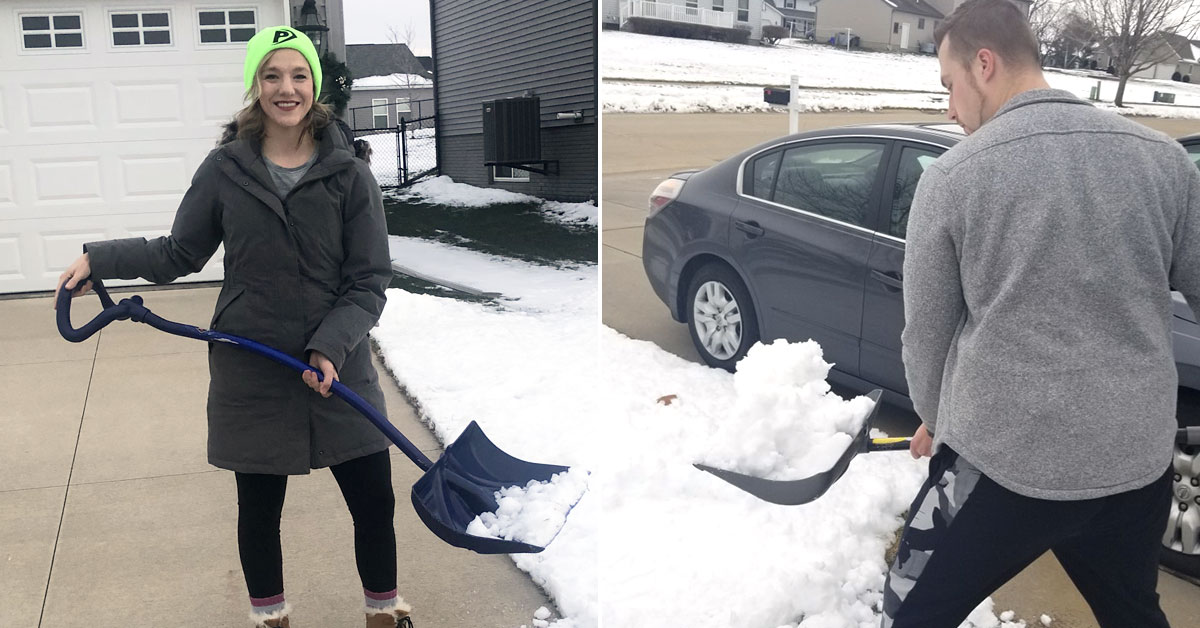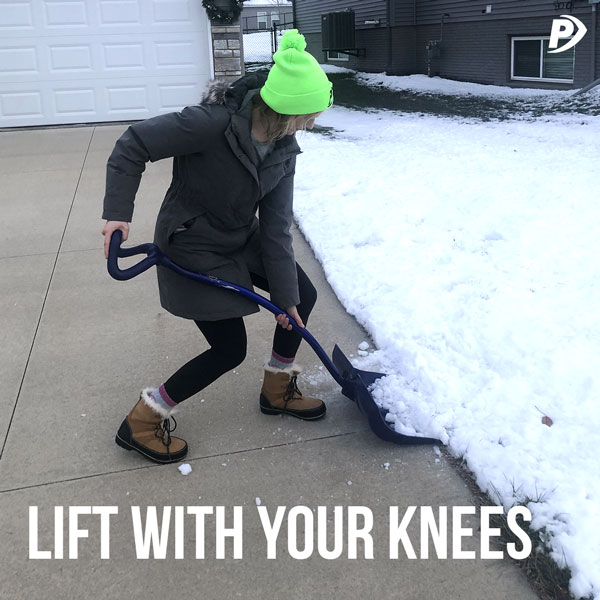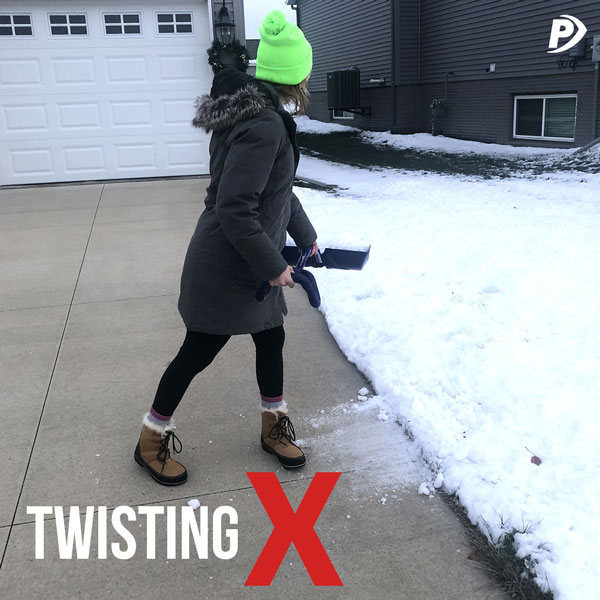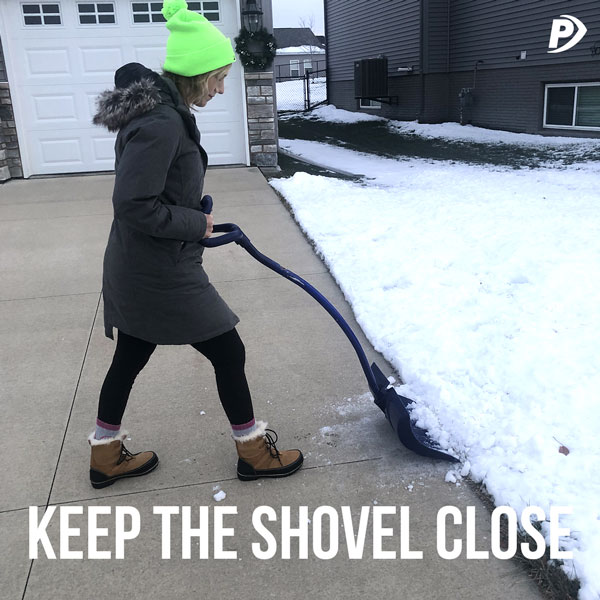5 Tips to Avoid Injury While Shoveling Snow

Written by Doctor of Physical Therapy, Aaron Sloterdyk, and Doctor of Physical Therapy, Linea Rochford
As the weather changes and things start to get cooler, we need to start thinking of everyone’s favorite chore; snow shoveling. Snow shoveling is an intensive task that leads to an average of 11,500 injuries and medical emergencies each year. To free up your sidewalks and driveways in an effective manner while still saving your back it is important to choose the right shovel, use proper lifting mechanics, and take your time.
Choosing the Right Shovel
A shovel is made up of two parts, the blade, and the handle. There are many different types of blades and handles out there so it’s important to understand the difference to best choose the shovel that fits your needs.
Blades can be broken down into shape, size, and material.
Blades of a snow shovel are either rounded shape or rectangle-shaped. The rounded blade is designed for scooping snow while a rectangle blade is designed for pushing or plowing snow. Both can be used for cutting into large snowdrifts leftover by plows. Sizes usually vary between 12-24 inches for a rectangle blade and 12-18 inches for a rounded blade. The rounded blades also come in various depths. Choosing the right size comes down to how big of an area you need to scoop and how much you can lift. Bigger areas do better with bigger shovels but only to the point where you can comfortably lift. If you are unable to comfortably lift the snow, then you may end up hurting your back. The last part of choosing a blade is the material. Metal blades are more durable but much heavier. They do better over rock or gravel and will last you several years. Plastic blades are more lightweight and easier for people to lift. However, they can more easily break and don’t always last as long.
Handles can be broken down into shape, length, and material similar to blades. Handle shapes are either normal straight handle, ergonomically-shaped, dual handle, and folding/telescoping handles. Normal straight handles are what you see most often. Ergonomic handles have a curve down the shaft that reduces the need to bend over while shoveling. Their design however makes it more difficult to lift the snow and does not do as well as a straight handle for scooping. Dual handles have a second handle lower towards the blade and allow for a better grip and easier lift while scooping. Folding/telescoping handles are designed for easier storage and are ideal to be kept in a vehicle for emergency situations. Length varies from 24-32 inches. Your choice will depend on your height and stature. When holding the shovel, you should feel a slight bend in your knees and not feel like you need to bend heavily at your waist to scoop snow in front of you. There are two lightweight and two heavier materials for shovel handles. Lightweight materials are aluminum and plastic. Aluminum while lightweight, is prone to rust and bend if not taken care of properly. Plastic is most people’s choice if weight is a concern for the shovel. It is easy to handle but can be prone to cracking if left out in the elements. The heavier choices are wood and fiberglass. Fiberglass is the heaviest choice but it is very durable, does not rust, and won’t bend. Wood is more lightweight than fiberglass but more durable than plastic or aluminum. It does have some maintenance needed to keep it working properly.
Once a shovel is chosen there are a few things to keep in mind once actually shoveling the snow.
See more about selecting the right shovel at Backyardville.com >>
Proper Lifting Mechanics for Shoveling Snow
A warm-up prior to shoveling is very beneficial. You are much more prone to injury if you are coming right out of bed or have been sitting around for a period of time. A brisk walk for several minutes and some general arm/shoulder stretches will help get the blood flowing and reduce the risk of injury.
Five Tips for Reducing Risk of Injury when Shoveling Snow
1. Take more small scoops rather than fewer large scoops. Smaller scoops mean less weight and less strain on your body.

2. Lift with your knees instead of your back. Keep your back mostly upright and bend your knees. Lift by straightening your knees.

3. Switch scooping sides frequently and try to scoop evenly on both sides of your body. Only scooping on one side can lead to overuse of that side and can cause extra strain on your muscles and joints.
4. Avoid twisting, especially when your shovel is loaded with snow. Instead of twisting your spine to throw the snow, try pivoting on your feet and keeping your back mostly straight.

5. Keep the shovel close to the middle of your body, when possible. Pushing the handle of your shovel from around your belly button places less strain on your back.

Take Your Time
Take your time when shoveling. Shoveling smaller amounts of snow will reduce the tension and load to your spine and legs. If the snow is very deep, removing it in layers can help you stay fit and active all season.
///
If you do experience low back pain or other issues due to shoveling snow, contact Performance Therapies to schedule an appointment with one of our Physical Therapists.